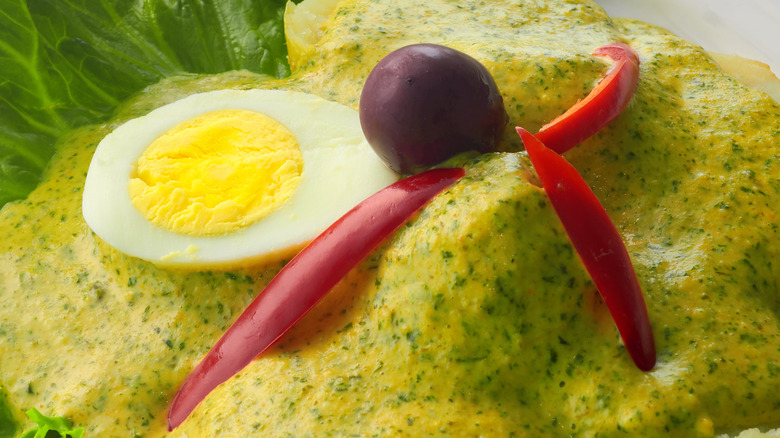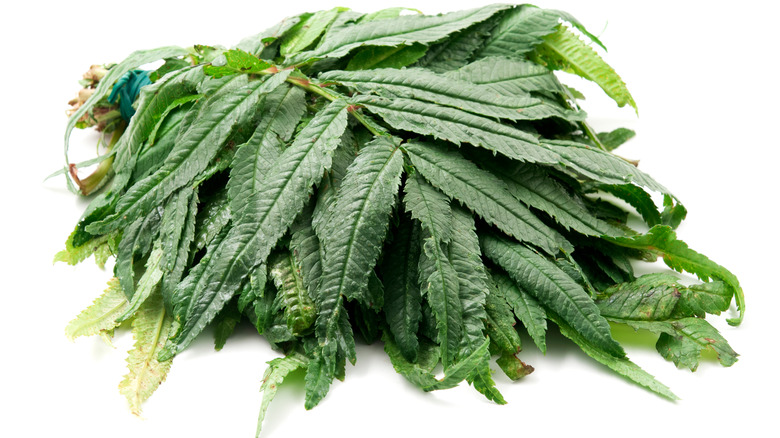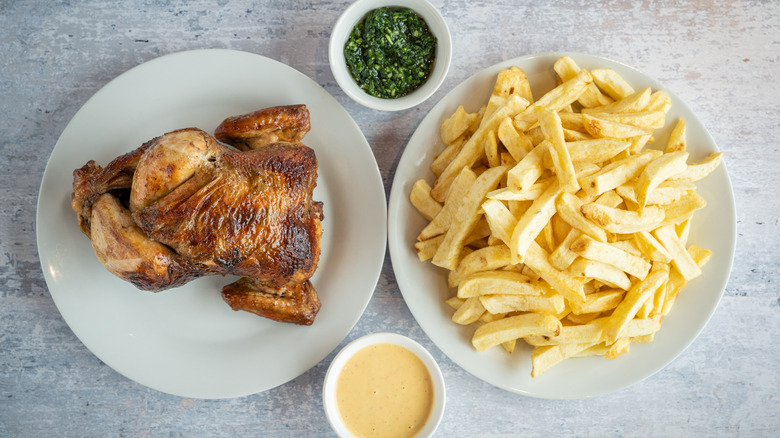Huacatay: The Trendy Mint Sauce You Should Try Next
When an exciting "new" ingredient trends, all the influencers and celebrity chefs start using it — and then you find out that it's been around forever. It's just new to mainstream American food culture. Huacatay, or black mint, is one of these ingredients. Huacatay hails from the western Andean region of South America, especially southern Peru (per Spiceography). The area's cooking celebrates a bounty of unique plants used as herbs, spices, and medicines.
Much of the world is familiar with black pepper, cumin, and cilantro — and introduced ingredients from Europe and Asia like basil and garlic, Spiceography writes. But there are some plant products specific to South America that define the cuisine there. These include aji amarillo, a hot and slightly fruity pepper, and paica — also known as epazote, per Spiceography, with a flavor that can be difficult to describe but isoften compared to tarragon or mint.
Another South American herb that captivates chefs is huacatay. Specialty Produce explains that huacatay or black Peruvian mint (or black mint, Mexican marigold, mint marigold, and other names) is not a mint at all but so-called for its sweet, menthol-esque flavor. The plant is actually related to marigolds, which hold deep significance in South and Central American culture — also used for Dios de los Muertos or Difuntos celebrations (per Cultural Mixology and National Public Radio).
Aside from its significance Peruvian cuisine, bunches of fresh and dried huacatay are also used in Africa to deter pests, says Specialty Produce, and it's prized for its antioxidants, fatty acids, and health-boosting properties.
How to make huacatay sauce
In Peruvian cooking, a little goes a long way because the ingredients used are packed with interesting and versatile flavors. According to International Cuisine, the food of Peru centers around sauces or aji – the Peruvian equivalent of salsas. These sauces call for chili peppers, herbs, and acids like lime juice or vinegar with bright colors and flavors to compliment a wide variety of dishes. They also tend to be thinner than the chunky, vegetal condiments with which many Americans are familiar, and these sauces are used more as condiments than dips.
The popular sauce using huacatay is called aji verde or "green sauce." It's easy and quick to make at home with a blender or food processor — try this simple recipe from A Cozy Kitchen. Their website suggests adding cilantro to the sauce as huacatay can be difficult to acquire in large amounts. Amelia Saltzman, writer for Los Angeles Times, uses an immersion blender to make the sauce, and International Cuisine posted a creamy version made with cotija or Parmesan cheese.
How to find and eat huacatay
Now that you're ready to try cooking with huacatay, where can you get it? While you can certainly buy ready-made paste or sauce online, you can also order seeds and try your hand at growing it yourself. There's nothing like adding homegrown fresh herbs to a meal. Plus, The Seed Vault explains that the black mint plant is pest-resistant and makes a good border plant to cultivate around your garden.
But how do you cook with it? Being both mountainous and having a coastline, Peruvian cuisine is known for both hearty meat and vegetable dishes as well as seafood preparations like ceviche mixto. America's Test Kitchen (ATK) praises both aji verde and aji amarillo (made with fruity yellow chilis) as the must-have sauces for traditional pollo a la brasa — smoked and grilled Peruvian chicken. It will elevate any roasted chicken dish.
ATK editor Rebecca Hays also enjoys aji verde on eggs and grains, and just as much as tacos and burritos. While it's often served with queso fresco, huacatay could work with other mild, soft cheeses like feta or chevre, and with shareable foods like chalupas and sopas. LA Times's Amelia Saltsman utilized aji verde to great effect in her ceviche party where she paired it with guacamole and potatoes — Peru grows thousands of varieties because they're endemic to the region (per International Cuisine). Be sure to get a few colorful varieties to slather with this special sauce.
Specialty Produce also states that huacatay is a key ingredient in locro, an Andean pumpkin stew, but it also goes great in everything from cocktails to risotto. The sky's the limit — it's high time to add this unique Andean minty marigold to your spice cabinet.


